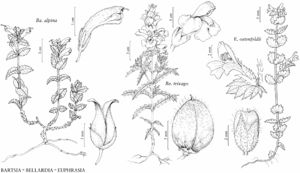Bartsia
Sp. Pl. 2: 602. 1753.
| Taxon | Illustrator ⠉ | |
|---|---|---|
 | Bartsia alpina Bellardia trixago Euphrasia ostenfeldii | Yevonn Wilson-Ramsey Yevonn Wilson-Ramsey Barbara Alongi |
Herbs, perennial; hemiparasitic, caudex woody. Stems erect, not fleshy, pilose and eglandular at base, hirsute and glandular at apex. Leaves basal (scalelike) and cauline (expanded), decussate; petiole absent; blade not fleshy, subleathery or not, margins crenate to serrate. Inflorescences terminal, racemes; bracts present. Pedicels present; bracteoles absent. Flowers: sepals 4, calyx bilaterally symmetric, tubular, lobes triangular; petals 5, corolla violet to yellow, strongly bilabiate, funnelform, abaxial lobes 3, adaxial 2, adaxial lip galeate; stamens 4, didynamous, filaments minutely pubescent; staminode 0; ovary 2-locular, placentation axile; stigma subcapitate. Capsules: dehiscence loculicidal. Seeds ca. 50, white, fusiform-cylindric, wings present. x = 12.
Distribution
ne North America, Europe
Discussion
Species 1.
Until recently, Bartsia included 49 species distributed in North America, South America, Eurasia, and Africa (U. Molau 1990). However, phylogenetic analyses of nuclear and chloroplast genes, obtained using both traditional and high-throughput sequencing, indicate that Bartsia so circumscribed is polyphyletic (S. Uribe-Convers and D. C. Tank 2015, 2016; Uribe-Convers et al. 2016). The type species, B. alpina, is recovered on a branch with no other species of Bartsia; therefore, Bartsia is herein treated as monospecific following Uribe-Convers and Tank (2016). The remaining species of Bartsia have been placed in Bellardia, Hedbergia Molau, and a new South American genus, Neobartsia Uribe-Convers & Tank. Of these, only Bellardia occurs in the flora area.